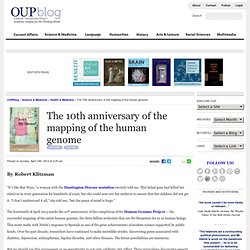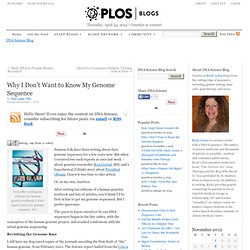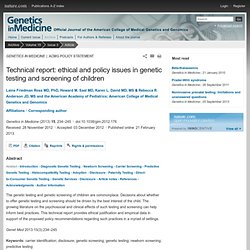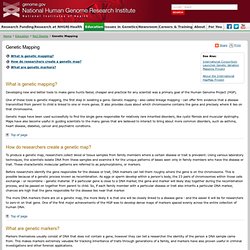

The Genographic Project. Criminomics: stopping crime before it starts. Dylan looks like any normal six-year-old.

He is bright and a little mischievous, has many friends, and is praised by his teachers as a model student. But his normalcy is only skin deep. In his cells lies the DNA of a murderer. Though Dylan has gene variants that give him a more than 90% chance of premeditated mass murder, he will never commit a crime. Thanks to early intervention by doctors, Dylan’s criminal tendencies were identified before birth. Dylan is one of the success stories of the Criminal Genome Project, or CGP, the effort to sequence the complete set of genes involved in murder and other antisocial behaviors.
The CGP is run by Dr. “It was an obvious thing to do,” O’Day said. In fact, the motivation had been there for 150 years. The 10th anniversary of the mapping of the human genome. By Robert Klitzman “It’s like Star Wars,” a woman with the Huntington Disease mutation recently told me.

This lethal gene had killed her relatives in every generation for hundreds of years, but she could now test her embryos to ensure that her children did not get it. “I don’t understand it all,” she told me, “but the peace of mind is huge.” The fourteenth of April 2013 marks the 10th anniversary of the completion of the Human Genome Project — the successful mapping of the entire human genome, the three billion molecules that are the blueprints for us as human beings. This event ranks with NASA’s response to Sputnik as one of the great achievements of modern science supported by public funds. But we should use this anniversary as an opportunity to not only celebrate, but reflect. Mice have about 20,000 genes. Over the past 10 years, the costs of sequencing a human genome have also plummeted from $100 million per person to less than $1,000.
Subscribe to the OUPblog via email or RSS. Why I Don’t Want to Know My Genome Sequence. Hello there!

If you enjoy the content on DNA Science, consider subscribing for future posts via email or RSS feed. Rating: +9 (from 11 votes) Even after writing ten editions of a human genetics textbook, I don’t want to know my genome sequence. Yet. Famous folk have been writing about their genome sequences for a few years now. Or, in my case, inaction. Court: Human genes cannot be patented. Unanimous ruling a compromise; court says synthetic material, cDNA, can be patentedActress Angelina Jolie drove attention to the issue involving breast cancerIssue was whether "products of nature" could be treated similarly to human inventionsCompany at center of case says decision upheld a key claim on synthetic DNA Washington (CNN) -- The Supreme Court unanimously ruled on Thursday that human genes cannot be patented.

But in something of a compromise, all nine justices said while the naturally occurring isolated biological material itself is not patentable, a synthetic version of the gene material may be patented. Legal and medical experts believe the decision will have a lasting impact on genetic testing, likely making varieties more widely available and more affordable. The overriding legal question addressed was whether "products of nature" can be treated the same as "human-made" inventions, allowing them to be held as the exclusive intellectual property of individuals and companies.
European Journal of Human Genetics - Life insurance: genomic stratification and risk classification. Otago039079. 49-Micheletti. Technical report: ethical and policy issues in genetic testing and screening of children : Genetics in Medicine. Virtually every infant in the United States has blood collected to screen for a variety of metabolic, endocrine, hematologic, and infectious conditions within the first week of life.

State-administered newborn screening programs arose following Guthrie’s development of an assay in 1961 to detect phenylketonuria using dried blood spots collected on filter paper. Initially, some professional groups opposed the rapid population-based implementation of this assay, citing the lack of long-term data on the dietary intervention and correctly predicting that a subset of children could be harmed by overtreatment.21 However, the devastating nature of phenylketonuria, its treatability, and the availability of an inexpensive assay made wide-scale population screening both feasible and acceptable. The ACMG report recommended 29 primary targets for universal screening. Co410. Mental. Genetic Mapping Fact Sheet. Genetic Mapping What is genetic mapping?

Developing new and better tools to make gene hunts faster, cheaper and practical for any scientist was a primary goal of the Human Genome Project (HGP). One of these tools is genetic mapping, the first step in isolating a gene. Genetic mapping - also called linkage mapping - can offer firm evidence that a disease transmitted from parent to child is linked to one or more genes. It also provides clues about which chromosome contains the gene and precisely where it lies on that chromosome. Genetic maps have been used successfully to find the single gene responsible for relatively rare inherited disorders, like cystic fibrosis and muscular dystrophy. Top of page How do researchers create a genetic map? To produce a genetic map, researchers collect blood or tissue samples from family members where a certain disease or trait is prevalent.
What are genetic markers?